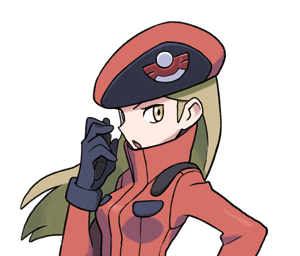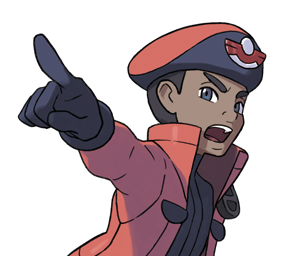

The Guild Alliance
{
With their headquarters in Fortree City, the Guild Alliance oversees the defense of human settlements against wild Pokemon's incursions. While they have their own forces, they will often call upon Trainers to help them if the need arises, and many selfless Trainers answer their call.
Recent attacks have been trickier to repel, a report says, and so they advertise for help throughout the continent.
The Guild Alliance tests your strategic prowess, where careful positioning and a united front are key to victory. Fight your way against waves of mooks and send your opponents packing!
Guild Alliance Summary
Playing in the Guild Alliance means more than just battling what's placed in front of you. To conquer the Maps of the Guild Alliance, you'll need to use your cunning to position your units to leverage their strengths and protect their weaknesses; and you'll need to prepare the field before the battle. With strategy and foresight, every fight will be on your terms!
Positioning on the map is your key form of matchup control during Guild Alliance tasks. You may find certain moves, abilities, and so on more or less effective than they would be in a standard match. Prepare your team, and defend the realm from foes great and small!
For Entry
- Players and referees must be T.Lv2 or higher.
- Players can sign up for either General Maps or High Danger Maps.
- General Maps: Sign up for the Level you want to play; when taken, the Referee rolls which Map at that Level you’ll play (equal odds among available Maps).
- High Danger Maps: Sign up for the specific Map you want to play.
- Taking a Job with the Guild Alliance costs JC, depending on the level of the Map challenged.
Level | 1 | 2 | 3 | Pinnacle Small Map | Pinnacle Large Map |
|---|---|---|---|---|---|
Player Entry Cost | 7 | 8 | 10 | 20 | 24 |
Default Format
General Maps: Bring 4, Pick 3 vs. Map
High Danger Maps: Bring 3, Pick 3 vs. Map
Round Hours: 72 hours
Battle Hours (Player): 72 hours
Battle Hours (Referee): 120 hours
Backpack Size: 7
Step Count: 1
Substitutions: 3 per Team
Tech: Map Level - 1
Switching: Off
The Map
Battles of the Guild Alliance take place on the Map, which is an X by Y grid of Tiles.
Maps contain Tile Types, Objects, and Objectives, each defined below. The Tile Types, Objects, and Objectives present for each Map will be defined within that Map's data.
Instead of each team having a field (for field conditions like Light Screen or Stealth Rock), instead, each tile has a field. Battle Conditions still affect the entire battle.
Starting Positions: Each map specifies where the Challenger's Pokemon begin. When signing up, the Challenger indicates which of their Pokemon starts at each position. At the start of the battle, each of the Challenger's Pokemon, and the Referee's specified enemy Pokemon, are placed at their starting tiles.
Tile Types: Each tile on the Map has a Tile Type. Tile Types are defined on a per-map basis, though most maps include a default tile type with no effects. Tile Types may restrict movement, modify movement costs, provide effects when a Pokemon starts or ends their turn there, or other effects in the same vein.
Objects: Objects are neutral, tile-occupying game pieces. Some Objects can be interacted with (like switches), while others serve as obstacles (like pillars). Objects cannot be moved onto or through, under normal conditions.
Objectives: Each map specifies one or more Objectives that must be met to achieve victory, provided by the different Master Guilds. Objectives are either Main, which is the condition which must be completed to emerge victorious, or Side, non-essential objectives which provide additional rewards if completed. Do note that once the Main Objective is completed, the Map ends.
Common Objectives include:
- Sharpening your skills against many opponents for the
 Training Guild.
Training Guild. - Defeating powerful threats for the
 Big Game Guild.
Big Game Guild. - Holding strong against an incoming siege for the
 Defense Guild.
Defense Guild. - Charting and reshaping the area in favour of the alliance for the
 Recon Guild.
Recon Guild. - Retrieving key items or people from the enemy's grasp for the
 Rescue Guild.
Rescue Guild.
Defeat Conditions: If this condition is met, the Map ends with Player loss. Players may still claim rewards for any Side Objectives they have completed. All Player Pokemon being Fainted is an assumed Defeat Condition for all maps, unless specified otherwise.
Battle Flow
Each battle progresses through a series of phases, with players alternating as the active player. By default, the Challenger is the active player for Round 1.
By default, battles are played with Switching: Off.
After each round completes, the active player role switches.
Movements & Orders
Each active Pokemon may receive up to one (1) Movement order and one (1) Order in a round. Pokemon receiving an Order may also receive Substitutions. The total substitutions issued to Pokemon receiving orders in a round cannot exceed the team's Substitution limit.
Movement must be completed before a Maneuver.
(You cannot maneuver before moving, nor split a movement around a maneuver.)
Movements
By default, each team has Movement available to them equal to their number active Pokemon, plus one (1). Movement is in one of the four cardinal directions. No Pokemon may move more than two (2) tiles.
Only one Pokemon may occupy a tile at a time. A Pokemon may pass through tiles occupied by allies but must end on an unoccupied tile. A Pokemon cannot pass through tiles occupied by enemies, Objects, or tiles for which it does not meet the requirements.
Only one Pokemon may occupy a tile at a time. A Pokemon may pass through tiles occupied by allies but must end on an unoccupied tile. A Pokemon cannot pass through tiles occupied by enemies, Objects, or tiles for which it does not meet the requirements.
Orders
Interact is a Command available to all Pokemon on the Map. Each Maps' objects will specify what Interact does, if anything. By default, Interact does not cost Energy. Additional Commands may be defined by Maps, for use on those Maps.
Combat is a shorthand term for the Battling Phase as it takes place in the Guild Alliance.
To receive an order, a Pokemon must be adjacent to an opponent or Object after their movement (or declining to move). For each order against an opposing Pokemon, that Pokemon gets a chance to receive an order and take a turn in response. This comprises a Step. Initiate Combat is a shorthand term for this process. The two Pokemon, the initiator and the responder, are said to be In Combat for the duration of that Step.
If that Pokemon is adjacent to multiple opponents, specify which opponent you are Initiating Combat against.
An order may contain Substitutions if that Pokemon Initiated Combat (i.e. Pokemon receiving an order to use Interact cannot receive substitutions). Substitutions may only have targets in their result clauses that contain Pokemon in that Combat, their teams, or the battle.
Combat is a shorthand term for the Battling Phase as it takes place in the Guild Alliance.
To receive an order, a Pokemon must be adjacent to an opponent or Object after their movement (or declining to move). For each order against an opposing Pokemon, that Pokemon gets a chance to receive an order and take a turn in response. This comprises a Step. Initiate Combat is a shorthand term for this process. The two Pokemon, the initiator and the responder, are said to be In Combat for the duration of that Step.
If that Pokemon is adjacent to multiple opponents, specify which opponent you are Initiating Combat against.
An order may contain Substitutions if that Pokemon Initiated Combat (i.e. Pokemon receiving an order to use Interact cannot receive substitutions). Substitutions may only have targets in their result clauses that contain Pokemon in that Combat, their teams, or the battle.
This is to say, if you use Close Combat against an opponent, you can sub for their Protection with Swords Dance or Sandstorm for example. You cannot sub to attack a different opponent.
Special Combat Rules
All Pokemon, who haven't Fainted or left the map by other means, are in Play. When a Combat begins, Pokemon do not enter play (as they are already in play), nor do they exit play as Combat ends. As a reminder, Switching is Off.
Effects that trigger "When this Pokemon enters play" (or similar) now trigger "When this Pokemon Initiates Combat". Effects that trigger "When this Pokemon leaves play" (or similar) now trigger "After Combat this Pokemon Initiated".
By default, Objects cannot be targeted by actions other than Interact.
If a move creates a Hazard; instead, it doesn't. Otherwise, Field Conditions and Battle Conditions affect their respective teams without concern for Map location.
During a Pokemon’s turn: Pokemon occupying tiles that aren’t that Pokemon’s tile or a tile adjacent to it are treated as Inactive.
Moves with the Targeting Scope of All Allies, All Opponents, and All Other Pokemon will target any Pokemon (within their respective scopes) that are on a tile adjacent to the user.
Effects that trigger "When this Pokemon enters play" (or similar) now trigger "When this Pokemon Initiates Combat". Effects that trigger "When this Pokemon leaves play" (or similar) now trigger "After Combat this Pokemon Initiated".
So abilities like Intimidate work if you're being proactive, but not reactive.
By default, Objects cannot be targeted by actions other than Interact.
If a move creates a Hazard; instead, it doesn't. Otherwise, Field Conditions and Battle Conditions affect their respective teams without concern for Map location.
During a Pokemon’s turn: Pokemon occupying tiles that aren’t that Pokemon’s tile or a tile adjacent to it are treated as Inactive.
Moves with the Targeting Scope of All Allies, All Opponents, and All Other Pokemon will target any Pokemon (within their respective scopes) that are on a tile adjacent to the user.
Example 1: A Pokemon on tile C3 orders Earthquake against an opponent on tile C4. That Earthquake would target that opponent on C4, an additional opponent on C2, and an ally on B3. It would not target an enemy on A1 or an ally on B1.
Example 2: A Pokemon on tile C3 orders Coaching in combat with a Pokemon on tile C4. Their ally on B3 is adjacent to them. Their ally on B1 is not, and is treated as Inactive. So the Pokemon on C3 and B3 get their Attack and Defense stages increased, but not the Pokemon on B1.
This rule does not make enemies targeted by ally/ally team only moves or allies targeted by enemy/enemy team only moves. You don't Aromatherapy opponents or Heat Wave allies.
Sign-up Template
Code:
[B]Thread:[/B] (thread)
[B]Map (Level):[/B] (map if you're going a High Danger map, otherwise map level)
[B]Backpack:[/B] (7 items)
[B]Pokemon:[/B] (Pokemon profiles)
Last edited:




 Mamo (Greendent)
Mamo (Greendent) Duo (Greedent)
Duo (Greedent)













